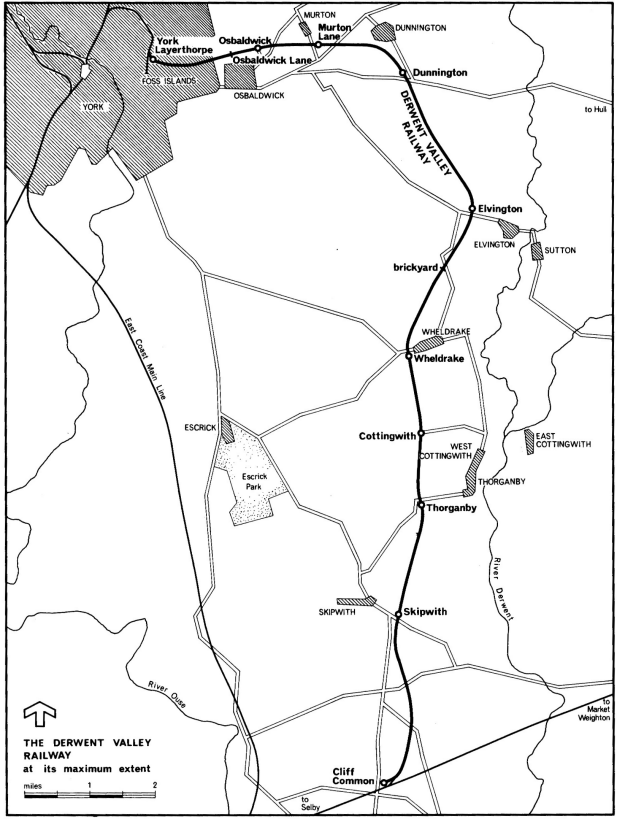
| THE INDUSTRIAL RAILWAY RECORD |
© NOVEMBER 1973 |
THE DERWENT VALLEY RAILWAY
60 YEARS ON
R.R. DARSLEY
An article on the Derwent Valley Light Railway (DVLR) in the RECORD? Certainly, its opening on 19th July 1913 was described by the local newspaper in rural rather than industrial terms:- 'an epoch in the lives of the populous district of Layerthorpe, giving them excursions into beautiful countryside unknown to many'. Today, still predominantly in a gentle pastoral landscape, it conjures in the mind of the enthusiast a railway atmosphere essentially English. Time, however, has brought changes and the railway company has changed to meet them. The once crowded Layerthorpe area of York is now virtually depleted of residents and the major part of the land has been scheduled for light industry. Regular passenger trains ceased to run on 31st August 1926, and the sundries and parcels service was withdrawn in September 1970. The railway, too, is shorter now but the traffic it carries - coal, fuel oil, cement, and bulk grain - permits its inclusion in the interest of the industrial railway enthusiast. But who needs to be pedantic? The DVLR has always exercised a particular attraction to those who have known it, partly because it has retained its individuality outside the net of Nationalisation and partly because of the friendly manner that goes with the small intimate concern. In 1963 it celebrated 50 years of service to the community and the local newspaper reporter described it as 'none the less a hard working commercial enterprise of which Yorkshire can be proud'.
The excellent monograph by Mr S.J. Reading ("The Derwent Valley Light Railway," Oakwood Press 1967) charts the history of the company up to 1967 and this article does not seek to compete on established ground. However, since 1967, several changes have occurred; the company has again purchased its own locomotives, the line has been further shortened and the types of traffic carried have altered. It is the purpose of this article to bring the story up to date.
At the end of the nineteenth century a goodly number of people living in the area administered by the Rural District Councils of Escrick and Riccall found themselves in a rail-less triangle formed by the North Eastern Railway lines linking York, Selby and Market Weighton. In 1898 the Councils first minuted their intention to improve communications in the area by taking advantage of the Light Railways Act of 1896. This is the only known case in which local authorities used their freedom under this Act to obtain an Order for light railway construction. This they were granted in 1902, but because of the difficulty in raising capital, it was not until 22nd July 1910 that a syndicate of local landowners, the councils and the NER was able to place a contract with Pethick Dix & Company for the construction of the line from Cliff Common to Foss Islands at an estimated cost of £80,000.
Although the southern end of the line (Wheldrake to Cliff Common) was opened without ceremony on 29th October 1912, the remaining 4½ miles of line had still not been laid by the end of the year. The contractors, like many before them, had difficulties meeting their financial obligations and there were many games of hide and seek between the bailiffs and the contractors' locomotive. An extract from a letter to Mr Thompson, agent for Escrick Park Estate and later Chairman of the company, reads 'I cannot imagine any work carried out under greater difficulties than has been the case this last week. The hunters of the locomotive were defeated on the first day but during the same night they removed the fittings of one cylinder of the Engine whilst at York, but not-withstanding this, the next day the loco was kept running on one cylinder. The end justified the means as it did excellent work, but the owners swept down again during the following night and definitely put it out of action ... The bailiff still holds the fort...!' The Manning Wardle 0‑6‑0 saddle tank used in the construction of the line has so far not been positively identified. According to Manning Wardle records Pethick Bros (presumably associated with Pethick Dix & Co) at one time or other owned the following six‑coupled saddle tanks: 597, 818 and 1208 (class K); and 1211 (class L). The locomotive used may have actually belonged to a subcontractor - perhaps James Byrom Ltd of Bury, who owned the wagons used on construction work. Pethick Dix eventually went bankrupt, but not on this contract, and any information concerning the identity of the Manning Wardle would be most welcome.

The inaugural train over the completed line ran on 19th July 1913 and regular passenger services started two days later. The NER hired out one of their departmental 2‑2‑4 tank locomotives, number 1679, for the opening and with the two ex‑NER six wheel coaches in dark blue livery with gold lettering the overall effect was most pleasing. The scene was further enhanced by the neat green and white station buildings. NER 1679 was normally used for working official saloons and its journey on the DVLR must have been one of the few occasions it worked a passenger train.
Passenger services reached a peak in 1915 with 49,383 passengers. The NER had agreed not to compete with their feeder and goods collection services, but despite the introduction of a DVLR feeder in the form of Mr A. Dawson's bus which ran between Sutton, Elvington and Elvington Station, passenger receipts declined with the improvement of road transport. Costs were cut by the use of twin Ford railbuses. While these were cheaper to run they were, like most of their breed, not very well regarded by passengers. Both railcars were purchased in May 1924 at a total cost of £1,070; each was built on a Ford 1‑ton truck chassis with bodywork by C.H. Roe Ltd of Leeds. Rated at 22hp, they weighed 2 tons 7 cwts, and were fitted with 17 seats. (Roe's are now part of the British Leyland Motor Corporation and other details for the railcars are obscure as their records for this period have been destroyed.) In order to use the units singly, small turntables were installed at Layerthorpe and Skipwith. During the General Strike in May 1926 the LNER borrowed the Ford railcars for use in the Harrogate area, but this was only a temporary measure. They were put up for sale in June 1926 and acquired by the County Donegal Railways for £480 the pair, arriving in Londonderry on 7th August 1926. Conversion to the 3ft gauge increased the total cost to £314 each. Before rebuilding they had looked somewhat wide and ungainly and this worried the CDR engineer. In the event, rather than narrow the body width drastically (from 7ft to 5ft 10in) it was decided to lower it over the rear wheels. These railcars were reasonably successful and lasted until 1934 when they were withdrawn from service.
The DVLR had not entirely given up passenger traffic and in 1928 special excursions were started with through trains to the Yorkshire coast as well as to the Agricultural Shows at Harrogate and Leeds. Trains ran to various stations on the line, especially for blackberry pickers. These were extremely popular and earned themselves the sobriquet of "blackberry specials". Latterly several railway society special trains have been accommodated - the Railway Correspondence & Travel Society in 1954 using class J21 0‑6‑0 65078; the Branch Line Society in 1958 with J21 65064; the RCTS again, this time jointly with the Stephenson Locomotive Society, in 1963 with Ivatt 46409; the RCTS yet again in 1965 with BR D2111; and, most recently, in 1973, the Locomotive Club of Great Britain using both the current DVLR diesel locomotives.
The freight traffic carried has varied with the passage of time. Initially it was potatoes, livestock, grain hay and straw, oilcake, manure, roadstone and round timber; nowadays it is potatoes, sugar beet, fuel oil, cement, coal, grain and agricultural machinery. As use by the agricultural trade gradually decreased, the DVLR sought to bring new traffic to the line by making available sites at the lineside for industry and storage. The company had a complete index for canvassing local farmers, for a time produced its own newspaper, and was to the forefront of agitation on behalf of farmers and traders.
The line survived the twin evils of the 1930's - agricultural depression and road competition - and found itself faced with a strenuous role during World War 2, imposed upon it for the now famous reason that from 3,000 feet up, the track was completely invisible! An Army ordnance sub‑depot was built at Tang Hall; Murton Lane Station was requisitioned by the War Department and a 40 wagon siding put in by them for the Northern Command Petrol Depot which had a capacity of 500,000 gallons, all stored in cans in adjoining fields. A siding to take 20 wagons was put in at Elvington for the construction of Elvington airfield - though this was not the first time that the DVLR had carried construction loads, for in 1931‑32 3,000 tons of material were carried for the construction of Osbaldwick electricity substation, including a transformer which was the biggest single load. A mustard gas store was put in at Cottingwith and an ex‑SECR brakevan, purchased in 1946, was converted to an ARP gas cleaning unit but was never used as such on the DVLR. Wheldrake became a fuel depot for 'Operation Fido' and the whole lineside was used for the storage of timber, coal and bombs. On top of all this agricultural traffic also increased. Station plans as built are included in Mr Reading's history: those appended show wartime alterations and present day layouts, such as remain. Not only were track improvements made during the War, but the line extended its services from Cliff Common into Selby and the DVLR brakevan displayed lettering to this effect.

The Contractors' Manning Wardle 0‑6‑0 saddle tank at "Elvington for Sutton" station with a train of wagons lettered 'James Byrom Ltd Contractors Bury': The young ladies in the first wagon look too demure to have been involved in games of hide and seek with the bailiff mentioned in the text! (Hanstock, courtesy DVR Co)
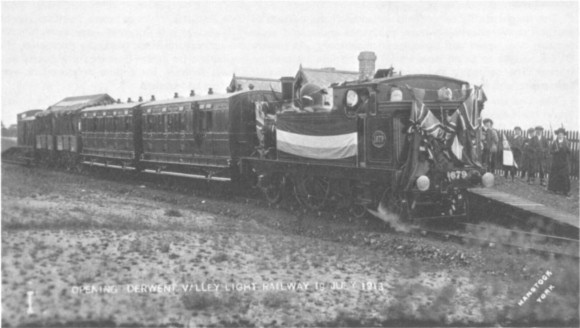
NER 1679 on the opening train, 19th July 1913. (Hanstock, courtesy DVR Co)
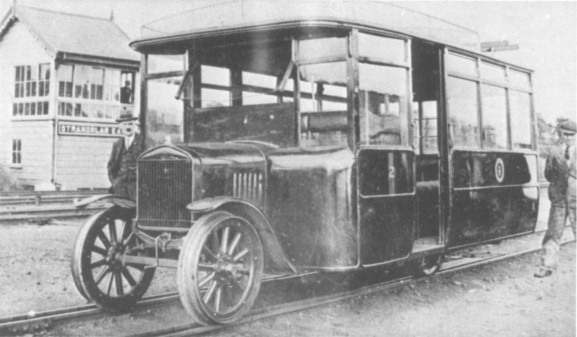
One of the ex‑DVLR Ford railcars, seen here as County Donegal Railways railcar 2, at Stranorlar. (Courtesy Dr E.M. Patterson)

Railcar turntable at Layerthorpe. (copyright CF. Klapper, courtesy DVR Co)
The very creditable performance by staff and the line itself is not without its amusing side. The LNER provided the motive power for the line at this time, mainly in the form of J21, J24 and J25 0‑6‑0's, with the occasional J71 or J72 0‑6‑0 side tank or 'Austerity' 0‑6‑0 saddle tank to shunt at Layerthorpe. One day a J71 set off from Layerthorpe with a massive load of 65 wagons. Had about 80 per cent of them been fitted with oil‑filled axle boxes all would have been well; but they were not and the train came to a halt at Tang Hall bank. Having divided the train and taken the first half to its destination, the loco came back for the remaining wagons. Just before Murton the J71 ran out of water - about equidistant from the water cranes at Wheldrake and York. The day was saved by a quick dash to Murton Lane Station where, because of the petrol store there was a large and very audible fire alarm. Within minutes the fire tender had turned out and the situation was saved!
At the end of the War came the nationalisation of railways. The DVLR was left out of the Act despite its initial interest in being included. 1947 saw operating difficulties as well. A winter, in which the snow drifted so deep that a guard stepping out of his van found himself up to his neck in a drift and helpless until he was dug out, was followed by a thaw and floods at Layerthorpe yard 3‑4 feet deep. The line was only kept running by rescuing the locomotive and stabling it at Osbaldwick. It was hoped that the reconditioning of Elvington airfield for the United States Air Force would bring more traffic and there was considerable movement of condemned private owner wagons for scrap. These were marked 'M.T.D.', and arrived at about 100 a week for some time after Nationalisation.
The impact of the Beeching plan led to the closure of the BR line from Selby to Market Weighton which meant that the junction at Cliff Common was taken out of use. The DVLR was then worked from the Layerthorpe end, but as the traffic generated by the Southern section was light it was decided to close the section between Wheldrake and Cliff Common on 31st December 1964. Marple & Gillott Ltd of Sheffield were awarded the dismantling contract, but no locomotives were used on this work.
The situation thus in 1967 was a truncated line from Layerthorpe to Wheldrake with the sites and trackbed south of this point being sold mainly to adjoining landowners. Most of the buildings are still intact and used for stores or stables, but some of the trackbed has been ploughed up. (Some of the buildings on the closed section are still in the original livery of green and white: in 1968 the stations from Layerthorpe to Elvington were repainted in light grey and stone with white nameboards displaying black lettering.) The shortened line served a store for the Ministry of Agriculture, Fisheries & Food at Wheldrake, a liquid fertiliser plant at Elvington, a grain drying plant and sugar beet loading bay at Dunnington, a pre‑mixed concrete plant at Osbaldwick and a mechanised coal depot and fuel centre at Layerthorpe.
When first opened, the line was worked by NER locomotives under a ten year agreement. There is evidence of NER class 398, and LNER J21, J24 and J25 0‑6‑0 classes working the line, as well as 1679, the 2‑2‑4 tank used on the opening day services. In September 1923 a petrol driven rail locomotive from the Four-Wheel-Drive Lorry Company[*] was given a month's trial but was not found satisfactory. It had a claimed haulage capacity of 160 tons on the level: in the event legend has it that it hauled five wagons five yards and then exploded!
Despite this initial set‑back, the company maintained its progressive image by purchasing in 1925 one of the early chain-driven Sentinel geared steam locomotives. The LNER was very interested in this vertical boilered locomotive (Sentinel 6076 of 1925 of class CE) and it worked down the line with a dynamometer car on at least one occasion. The principal dimensions were: four 2ft 6in diameter wheels on a 7ft wheelbase; boiler pressure, 275lb per sq in; cylinders, 6¾in by 9in; coal capacity, 10 cwts; water capacity, 300 gallons; weight, 22 tons. However, it was unable to cope with the increased traffic and was sold in 1927 to Thomas Summerson & Sons Ltd, Albert Hill Foundry, Darlington, for £500: Summerson's are now Lloyds (Darlington) Ltd and the loco, derelict by May 1960, was finally sold for scrap to T.J. Thomson & Son Ltd, Stockton, in 1971.
Prior to the disposal of the Sentinel, another motive power agreement was made with the LNER, who provided class N12 0‑6‑2 tank locos (such as LNER 2485) and class J71 0‑6‑0 tank locos (including LNER 449, later BR 68275) in addition to the classes mentioned earlier. This agreement was continued with BR.
* This is the title as per DVLR records. However, G.N. Georgano in "The World's Commercial Vehicles 1830-1964" (Temple Press Books, 1965) lists a British Four Wheel Drive Tractor Lorry Company (later Four Wheel Drive Motors Ltd) of Slough, Bucks, which traded from 1920 to 1932. It was formerly associated with Hardy Rail Motors Ltd, and merged with The Associated Equipment Co Ltd (AEC) in 1932. So far no vehicle specification or photograph has come to light, and further information would be welcome.

Sentinel 6076 of 1925, seen here at Layerthorpe soon after delivery. The predominant traffic on this particular train would appear to be sugar beet. (courtesy D VR Co)
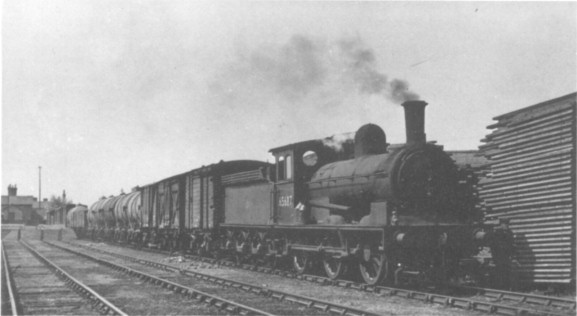
A view in the 1950's, showing a DVLR train about to depart from Cliff Common behind class J25 65687 (Darlington 1899) on loan from BR. (C.H.A. Townley)
Initially the arrangement included the provision of a crew by the main line company, but later only the locomotive was hired. BR found difficulty in supplying an appropriate steam locomotive eventually and so in 1961 the DVLR crews were retrained for driving 204hp Drewry 0‑6‑0 diesels.
In 1969, it was evident that with the phasing out of the 204hp diesel shunters by BR the difficulty of locomotive availability would be experienced once more. It was therefore decided that it would be simpler to buy sufficient locomotives to run the line than to risk non‑availability of locomotives of the correct type. Two serviceable 0‑6‑0 diesel mechanical locomotives were purchased that year from BR for working traffic - in April 2298 (Drewry 2679 of 1960, actually built by Robert Stephenson & Hawthorns, their works number 8157) and in May 2245 (Drewry 2577 of 1956, Stephenson & Hawthorns 7864). These have been renumbered No.1 and No.2 respectively. A third ex‑BR diesel of the same type, 2329 (Drewry 2710 of 1961, Stephenson & Hawthorns 8188), was bought part dismantled in 1969 from Peter Wood & Co Ltd of Eckington, near Sheffield; it possesses no power unit and is being cannibalised for spares. These Drewry locomotives, as built, were fitted with a Gardner 8L3 engine rated at 204hp (1200rpm) and weighed 29 tons 15 cwts. 2298 had 3ft 7in diameter wheels, but those of 2245 were one inch less. Mechanical transmission is achieved through a Wilson-Drewry CA5 type 5‑speed epicyclic gear box from a Vulcan Sinclair fluid coupling. The current basic livery of No.1 and No.2 is Minerva Grey, with black and yellow dazzle on the rear and front of the cab, and also on the radiator cover sides. Black is used for the cab roof, engine top cover, chimney, running board, cab handrails, steps, wheels and underframe. The buffer beams and buffer shanks are Salvia Red, as is the lettering on the cab side. A handlamp is carried at the front and back of the locos, mounted on a bracket over the centre of the three lower electric lights: these handlamps, the oiler and other sundry items are painted white with the individual loco number displayed on each in red.
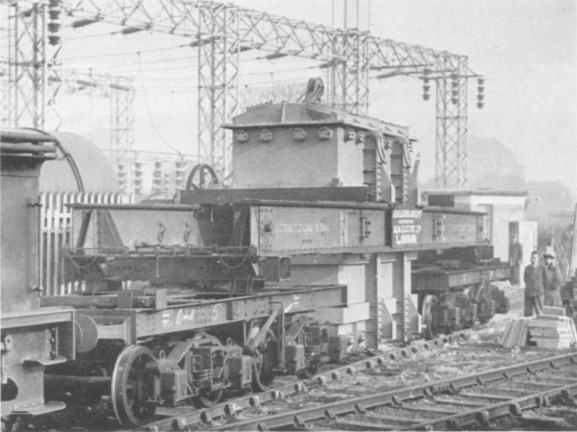
The heaviest single load to travel over the DVLR - a transformer entering Osbaldwick electricity substation in 1931. (copyright "Yorkshire Herald"; courtesy DVR Co)
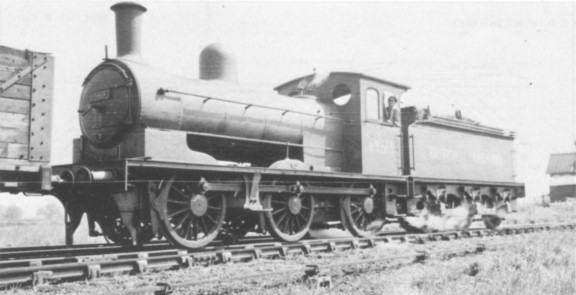
Class J24 65619 (Gateshead 1896) on loan from BR in June 1950 is seen at Cottingwith running tender first from Layerthorpe to Cliff Common. This locomotive worked the daily train (Monday-Saturday) during weeks ending 3rd and 10th June 1950. (K.P. Plant)
Since the publication of Mr Reading's monograph in 1967, the DVLR has been further cut back in two stages so that it now terminates at Dunnington. The materials kept in the Ministry of Agriculture, Fisheries & Food buffer depot at Wheldrake have changed in character and most stock is now held on a 15 year rotation basis which has consequently reduced traffic in and out of store. Receipts from Wheldrake were not therefore sufficient to warrant maintenance and the section from there to Elvington was closed on 18th May 1968. The station site has been sold to Mr Simpson, the blacksmith in Wheldrake who also owns a garage in the village. Tracklifting was carried out by W. Bush & Co Ltd of Alfreton, who used their own diesel powered crane on this task.
Agriform Fertiliser Ltd opened a depot at Elvington Station on 11th October 1966 and development has gone ahead with production and storage facilities being built on the site. Unfortunately the rail traffic anticipated has not materialised. Agriform, a company jointly owned by Imperial Chemical Industries Ltd and Hargreaves (West Riding) Ltd, had depots based on BR stations - facilities which BR have tended to withdraw rather than develop. The major outlet for the DVLR Agriform traffic was to be the Newark depot but this has been given to an agent who has a road haulage concern and wishes to handle supplies with his own lorries. The only other traffic originating between Elvington and Dunnington was sugar beet from three farms, and as this was also likely to cease (as mentioned later) this section was closed on 22nd October 1972, the last train having run on 22nd June 1972. The track was removed by Thos. W. Ward Ltd and, although the Company still owns the land at Elvington, the trackbed has been sold to local landowners. No redundancies were involved and Agriform have leased the whole station area for future development. The Derwent Valley Railway now consists of a single line 4 miles 20 chains in length between York (Layerthorpe) and Dunnington, together with sidings totalling 1 mile 65 chains. Details of the present situation at each site are given below.
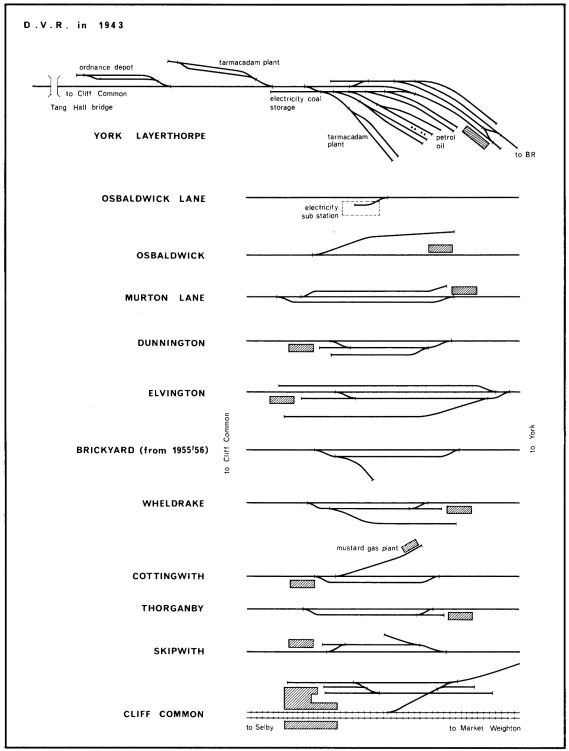

Dunnington Yorkshire Grain Driers Ltd have obtained a contract with the Distillers Co Ltd, Edinburgh, and built at Dunnington a drying unit and a mechanised handling system that allows the use of bulk grain wagons. This grain traffic is increasing and in 1972 amounted to 11,100 tons. There is at the moment only one filling point and to avoid levelling out the loaded grain manually it has been found necessary to shunt the wagons very slowly past this filling point. To achieve this Highlight (Grain Handling) Ltd, a subsidiary of Yorkshire Grain Driers Ltd, purchased an 0‑4‑0 diesel mechanical shunter (Fowler 4100005 of 1947) from Reed Board Mills (Colthrop) Ltd at Thatcham, Berks. (The Reed factory had changed from coke breeze to oil fuel and delivery of the latter is made by BR with no requirement for internal shunting.) Named CHURCHILL, the loco arrived at Dunnington in September 1971. It was originally painted green but its livery is now unlined black with polished metal nameplate and exhaust cap. Dunnington is the main centre on the railway for sugar beet loading and the 1972‑73 season (a light one) is to be the last for the crop, as the British Sugar Corporation Ltd has decided not to accept any further rail borne beet as part of a national policy. As such it wilI cost the DVLR some £1,500 annually in receipts. This contrasts with the situation in the 1965 harvest when the crop was so good in the York area that thousands of tons of beet had to be diverted to the BSC's Colwick factory at Nottingham for processing and the DVLR was preparing block trains of 500 tons for onward working by BR. Despite this decision by BSC the DVLR considers that the length of line has been stabilised and there remains a 10 acre site at Dunnington which has been opened for development.
Murton Lane The station yard here has been used by a scrap merchant, and some 440 yards from the line a new livestock centre for York has been built. Needless to say, the DVLR made strenuous efforts to be included in this complex, which has a livestock market and a slaughterhouse and ancillary depots. However, the land lying between the complex and the line has not been purchased for the scheme and the livestock pens have been built on the side farthest from the line. Movement of cattle by rail has decreased since the War, particularly with the decision by BR only to accept block trains of livestock. Despite the transhipment involved by road from the BR Foss Islands Yard to Murton livestock centre there has been little further decrease in rail traffic. Trains still arrive at Foss Islands from Birkenhead and Liverpool with cattle from Ireland every week and recently there has been some movement from the Holgate Loading Dock as well. That there is not necessarily a guarantee of such traffic continuing by rail was shown by the recent closure of the Menai Bridge which resulted in all livestock traffic from Holyhead going by road direct. The DVLR have submitted several schemes including one for a mobile unloading dock for railside use. However, the livestock centre is not really near enough to the railway and so the company would be involved in considerable expense to construct such facilities.
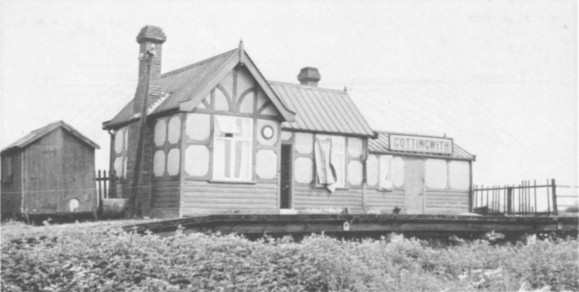
Cottingwith station in June 1950. (K. P. Plant)
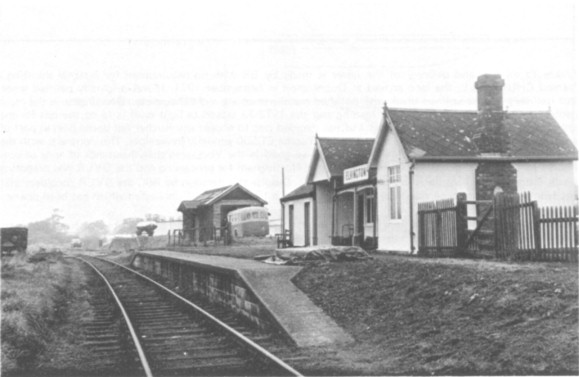
Elvington Station, looking north-east. 20th January 1967. (R. R. Darsley)
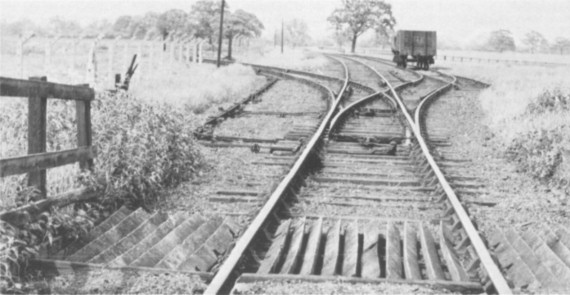
The layout at Cottingwlth in June 1950, looking north, showing the siding into the Royal Air Force depot which at that time was a sub‑unit to No.93 Maintenance Unit at Acaster Malbis. (K.P. Plant)
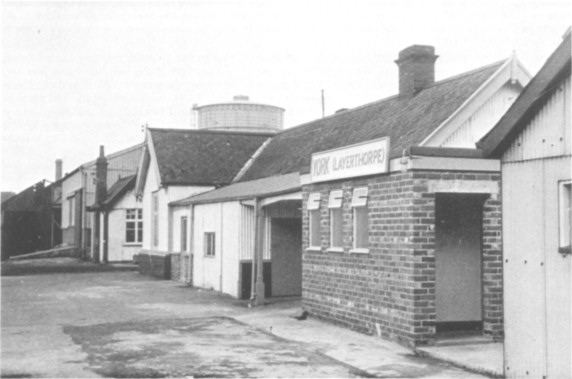
Layerthorpe Station, looking north, with locomotive shed in background. 20th January 1967. (R.R. Darsley)
Osbaldwick The cement traffic here has increased, totalling 5,600 tons in 1972. Available company sites have been developed to their fullest and a small industrial estate has sprung up near to the station. The Electricity Board substation complex at the other end of the village was closed and dismantled in 1968 and the siding into the yard removed. An interesting point is that this siding was not gated but actually ran under the metal fence around the substation, so four sections of this fence had to be removed every, time wagons were moved on the siding.
Layerthorpe The rail layout has been relaid to take the latest 100‑ton bogie oil wagons, this alteration being passed for service in January 1973. Oil traffic has increased, being 13,600 tons in 1972. A recent development in the fairly long association the DVLR has enjoyed with Shell-Mex & B.P. Ltd is the storage, during the summer months, of their private owner bogie oil tanker wagons. This has been done for three years now, usually from July to December, although in 1973 some arrived at the end of January, with winter following in February! These wagons are used for conveying industrial rather than household fuels.
The BR Foss Islands yard is now used for all 'full wagon load' freight for the York area and so has been more fully occupied than might be expected with the closure of the gasworks and power station rail systems. Lying behind Foss Islands, the Melrose-Layerthorpe area has been used for tipping by the council since 1931 and was originally scheduled for industrial development. This would have been of interest to the DVLR but in 1962 the decision was made to continue to use it solely as a tip. As a period of consolidation would be required before further development, it cannot be considered in the immediate future as a potential source of revenue to the DVLR.
In 1947 the DVLR constructed a series of coal storage units and on 13th October 1964 opened a fully mechanised coal depot at Layerthorpe in conjunction with Hargreaves (West Riding) Ltd. Distribution from this depot is over a radius of sixteen miles, the coal coming mainly from local collieries. The plant is open generally to the trade and initially proved of such interest to the public that 'open days' were held. Coal tonnage to York has decreased recently, reflecting perhaps the move to other forms of heating. At 27,000 tons in 1972 the amount carried by the DVLR was also down - though the coal strike contributed to this. It is hoped to make up for the total decrease in coal traffic to York by encouraging more retailers to use the coal concentration facilities.
The DVLR has always been forthcoming in its attitude to coal traffic. In 1909 they prospected for coal on the route of the line. Borings indicated that there was a continuation of the rich "Barnsley Bed" coal seam at Skipwith, but at considerable depth. The disposal of water was the great difficulty at that time but modern methods have solved this and it is interesting to note that the National Coal Board is at the moment engaged in test borings in the Selby area. The Barnsley seam here is from 900 to 2,700 feet below the surface and 11 feet thick with little waste. Additionally, there are three seams below the main Barnsley seam and the area of the find underlies Ryther, Cawood, Wistow, Kelfield, Riccall, Skipwith Common and North Duffield. The Government, worried about the uncertainty of continued oil supplies in the 1980's, has asked the CEGB to commission a design contract for a further coal-fired power station at Drax, some four miles south-east of Selby. This has strengthened the NCB's case for establishing a drift mine in the Selby area at Ryther and, subject to planning approval, it seems likely that work will commence in 1974 to exploit these newly discovered reserves. The roads in the area of the proposed drift are not at present suitable for heavy traffic and, although it might be feasible to take the coal out by barge down the river Ouse, there is a strong possibility that a new rail link will be put in to serve it. Depending on the site chosen rail access could be via Cawood (possibly on the course of the Cawood, Wistow & Selby Light Railway) or a completely new line might be built to Riccall. Even if the DVLR line in the Skipwith area had remained it is not likely that this would be used if only because of damage to Skipwith Common Nature Reserve.
An account of a typical winter day's operation of the railway is of interest as it includes the seasonal! beet traffic and gives a complete picture. The driver and guard book on at 8.00am, the former starting up the loco and checking oil, water and the like while the guard records details of inward wagons placed in the reception sidings by BR. These usually arrive at about 7.30am and consist of some twelve wagons of coal, ten loaded 45‑ton oil tankers, two "Presflo" vans of cement and ten empties ordered the previous day for sugar beet loading. The oil tankers are shunted into the oil discharge sidings, five to each road. This traffic is treated urgently as the tankers form part of a block train originating from Teesport Refinery and work to a strict timetable. The empties are then drawn out of the coal plant - an average of seven to ten on the first shunt - and a further batch placed in; these could be drawn from both storage and reception sidings. The remaining wagons in the reception sidings are then marshalled next to the loco or placed in the storage sidings. At approximately 10.30am BR deliver twelve empty "BGV's" (Bulk Grain Vehicles) which have travelled down from Scotland overnight on a Distillers Co train. These are added to the other vehicles to form the day's train. It departs about 11.00am and on arrival at Osbaldwick detaches the two loaded "Presflo" vans and attaches the two empties, thus maintaining a circuit working of these cement vans between Osbaldwick and Rugby.
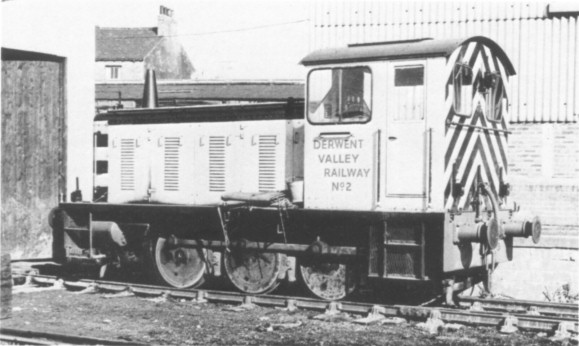
Derwent Valley Railway No.2 (Drewry 2577 of 1956) outside Layerthorpe shed in February 1970. (J.H. Meredith)
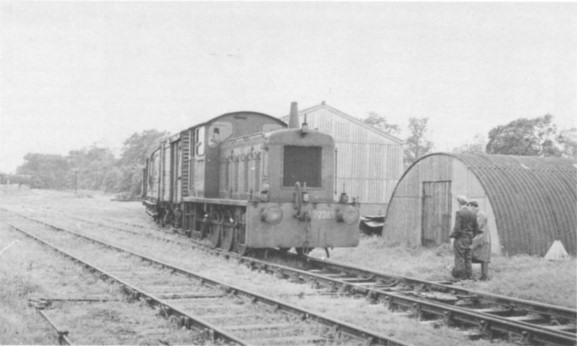
BR D2269 shunting at Skip with on 7th August 1962. (courtesy DVR Co)
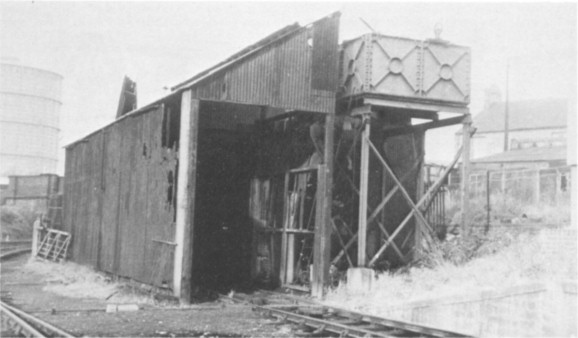
Locomotive shed at Layerthorpe, 20th January 1967. This has since been repaired in order to provide more suitable accommodation for the DVR Co's own locomotives. (R.R. Darsley)
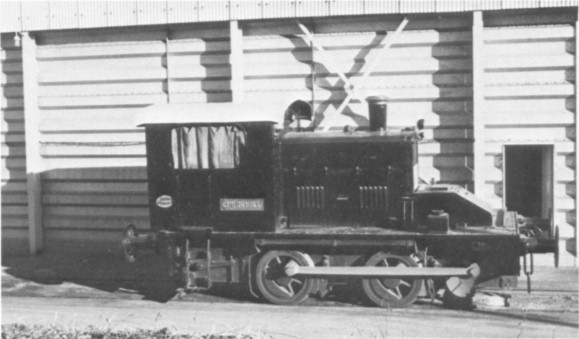
CHURCHILL, the Fowler diesel (4100005 of 1947) which is used by Highlight (Grain Handling) Ltd for shunting at Dunnington. 17th November 1972. (R.R. Darsley)
Continuing along the line, the train will detach four empties at Sledmere siding for sugar beet loading and attach the four loaded ones. At Dunnington the train is drawn clear of the siding so that CHURCHILL is able to come out on to the main line, draw off the "BGV's" and push them into the Yorkshire Grain Driers' siding. The DVLR loco runs round the remainder of its train, draws out the loaded beet wagons from the loading dock and replaces them by the empties. It is then ready to leave with its train (at about 2.00pm) for Layerthorpe where it arrives some 45 minutes later. In the meantime further wagons will have arrived here from BR at about 2.45pm. These are cleared, the coal plant shunted again, the empty oil tankers drawn out and all outgoing wagons placed in the reception sidings for BR to collect at 4.00pm.
If the beet traffic is heavy, the second DVLR locomotive will be at Dunnington to shunt the beet wagons in and out of the loading bay and will follow up with a loaded beet train later in the afternoon. In the summer the situation is not as busy and workings usually consist of a trip to Osbaldwick and one shunt per day at the coal plant, also one oil train per week. So, on average, there are 24 "BGV's" per week in the season, two oil trains per week in the winter and a daily service of cement. The locomotives are maintained at the weekends by a part-time fitter. They were received from BR in very good running order and so far no heavy overhaul has been required. The advantage of having two operating locos is that the traffic schedules can still be met in the event of one of them not being available. So far this situation has only arisen once.
In 1947, the company employed 33 people. This figure dropped to 23 in 1960 and 12 in 1967. Redundancies have to a large extent been offset by retirements, but the company has an outstanding record for the length of service from its employees and there are families who have third generations of Derwent men. It is this intimacy and goodwill within the system that makes comparisons with other companies a little unfair.
The company has always treated enthusiasts with a tolerance and understanding that not all have earned. They have always received a civil welcome and often it has been possible to obtain a pass to travel on the train. Saturday, 6th January 1973, saw a five coach excursion train work down the line, though the fog and the season prevented it from really being in the tradition of the old 'Blackberry Specials'. The North Western branch of the Locomotive Club of Great Britain organised the excursion from Warrington (via Manchester and Wakefield) and used both DVLR locomotives; No.1 from Layerthorpe to Dunnington and No.2 for the return. About 230 people took part and the company expressed themselves moderately pleased with the financial side of the venture. With the building of the National Railway Museum in York (1974‑75) and with steam working once more on the York - Scarborough line and possibly at the museum also, it is likely that even more enthusiasts will find their way to Layerthorpe than before. There have been requests by owners of preserved locomotives for the provision of running powers on the DVLR but the company, understandably, wishes to maintain full control over all operations on the line. However, might it not be that in the future we may see more workings in the nature of the 'Blackberry Specials' of old?
The future for traffic on the railway is tied closely to:
(i) The acceptance by BR of the traffic generated by the company so the latter is compelled to look for bulk loads as BR prefer these. For this reason the track has been relaid to cope with modern freight wagons and the railway has ceased to be truly described by the term 'light railway'. The company, therefore, as part of the change in image in keeping with the change in traffic, applied for a change of name to the Derwent Valley Railway Company. An Order to this effect was granted on 22nd March 1973. (ii) The development of industrial sites either owned by, or close to, the railway, in particular the 10 acre site at Dunnington. The temptation to let the site go piecemeal was resisted and outline permission for industrial development has been received. In a recent press interview Mr R.E. Cook, Chairman of the Derwent Valley Railway Company and Managing Director of Yorkshire Grain Driers Ltd, was quoted as saying that this site was the hope of real expansion. The line used to be 16 miles long 'just so that they could call it a railway' but the mileage remaining is the money-making section. Dunnington is very well sited for distribution and collection for the continent via Humberside. The new Grimston Bar flyover on the York South Bypass Road will be ¼ mile from Dunnington, but what makes Dunnington different from other available sites is the direct railway access to warehouses by track suitable for 100 ton containers on a railway that has had no strikes and no go‑slows in its 60 years of regional service.
In conclusion I would like to thank the Chairman and Board of Directors of the Derwent Valley Railway Company for permission to write this article and the General Manager (Mr J. Acklam) and his colleague (Mr S. Handley) for their unstinting help. I also extend my appreciation to Mr S.J. Reading for his valued comments on the manuscript, Dr E.M. Patterson for information and photographs of the County Donegal railcars, Mr K. Hoole for North Eastern Railway notes, and other members of the staff of the DVR and fellow enthusiasts for their assistance and permission to publish photographs.
Summary of freight traffic
|
year |
potatoes |
sugar beet |
livestock |
coal & coke |
stone |
| 1913 | 4,996 | 1,449 | 2,134 | ||
| 1922 | 6,658 | 3,792 | 4,006 | 2,515 | |
| 1932 | 2,456 | 1,036 | 4,443 | 33,616 | 6,375 |
| 1942 | 8,785 | 4,677 | 3,056 | 42,064 | 45,230 |
| 1952 | 3,572 | 9,483 | 278 | 21,498 | 1,425 |
| 1962 | 10,843 | 124 | 33,731 | 304 | |
| 1972 | 4,000 | 27,900 |
|
year |
oil |
spirit liquids |
timber |
cement |
grain and other |
| 1913 | 184 | 2,771 | |||
| 1922 | 1,660 | 6,343 | |||
| 1932 | 475 | 4,979 | |||
| 1942 | 3,990 | 33,086 | 1,488 | 11,812 | |
| 1952 | 9,593 | 14,917 | 3,289 | 3,264 | |
| 1962 | 8,652 | 19 | 4,989 | 3,909 | |
| 1972 | 13,600 | 5,600 | 13,247 |
Livestock were counted individually; otherwise all figures quoted are in tons.
BRUNTON'S LOCOMOTIVE. 'Philadelphia, a colliery village, stands about half a mile north of Newbottle. There are large engineering works here, belonging to the Earl of Durham, manufacturing locomotive and stationary engines, iron and brass castings, &etc, giving employment to a large number of men. "The Iron Horse" exploded here in 1815, the driver and fifteen other persons were killed, and many injured. "The Iron Horse"; a locomotive or engine on wheels, was pushed along by two legs outside the rails, attached to the piston or cylinder. It worked successfully for about twelve months, and drew twelve waggons, each holding about 50 cwt, at the rate of 4 miles an hour, from the Margaret pit to West Herrington, a distance of about two miles. It was afterwards altered, and the boiler made longer, to give it more power, with the object of making it draw twenty-four waggons. A large number of persons assembled to witness the start; the driver, anxious to gratify the spectators and make a good start, charged the boiler so strongly that it burst, killing the driver and fireman and fourteen others, besides injuring a large number. The explosion occurred near the present engine works, and many of the people were blown a considerable distance.' (From the second edition of "The History, Topography and Directory of the County Palatine of Durham" (Francis Whelan & Co, 1894), page 826. C.F. Dendy Marshall, on page 95 of "A History of Railway Locomotives down to the end of the year 1831," refers to two contemporary accounts of the accident, cited by Tomlinson. Do these confirm the suggestion above, that the original boiler had been lengthened? The assignation of a name to the locomotive is also of interest Is anyone able to say whether any coroners' inquest proceedings for the accident survive? — HWP)
'Various reasons have been given to the adoption of a certain gauge for a railway, but probably it was never before determined as it will be by a Florida company, which advertises for a locomotive, new or second-hand, and proposes to adjust the gauge of its road to that of the engine.' ("The Engineer," 8th August 1879. — REW)